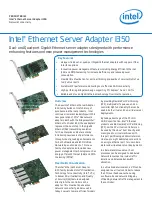
Scalable iSCSI Performance
An Intel Ethernet Server Adapter
I350 with native iSCSI initiators built
into Microsoft* Windows*, Linux*, and
VMware* ESX platforms provides a
simple, dependable, cost-effective
way to connect to iSCSI SANs. These
native initiators are broadly tested
using multiple generations of operating
systems, storage systems, and OS
tools to help ensure reliability and
ease of use. Standardizing on Intel®
Ethernet Adapters for iSCSI enables
administrators to use a single initiator,
TCP/IP stack, and a common set of
management tools and IT policies.
In addition, Intel® Ethernet Server
Adapters include a number of hardware
features designed to accelerate iSCSI
traffic and enhance data processing.
For example, TCP segmentation offload
and checksum offload capabilities
help reduce processor usage, increase
throughput, and deliver exceptional
iSCSI performance. Finally, using native
OS initiators, an Intel Ethernet Server
Adapter I350 supports the CRC-32 digest
instruction set included with Intel® Xeon®
processor products, which improves
transmission reliability and delivers an
enterprise-class iSCSI solution.
Power Management Technologies
Today, companies everywhere are
looking for ways to decrease energy
consumption across the enterprise
to reduce costs and environmental
impact, while at the same time
solving increasingly important power
density challenges. That’s why Intel
has introduced new, advanced Power
Management Technologies (PMTs)
with the Intel Ethernet Server Adapter
I350 family that enable enterprises to
configure power options on the adapter
and more effectively manage their power
consumption.
Energy Efficient Ethernet (EEE)
The Intel Ethernet Server Adapter I350
family supports the IEEE802.3az Energy
Efficient Ethernet (EEE) standard so that,
during periods of low network activity,
EEE reduces the power consumption of
an Ethernet connection by negotiating
with a compliant EEE switch port to
transition to a low power idle (LPI)
state. This reduces the controller power
to approximately 50% of its normal
operating power, saving power on the
network port and the switch port. As
soon as increased network traffic is
detected, the controller and the switch
quickly come back to full power to handle
the increased network traffic. EEE is
supported for both 1000BASE-T and
100BASE-TX.
DMA Coalescing
Another power management technology
that can reduce power on the server
platform is DMA Coalescing (DMAC).
Typically, when a packet arrives at a
server, DMA calls are made to transfer
the packet within the server. These calls
wake up the processor, memory and
other system components from a lower
power state in order to perform the tasks
required to handle the incoming packet.
Based on the configurable DMAC
settings, incoming packets are buffered
momentarily before any DMA calls are
made. This enables the controller to
intelligently identify opportunities to
batch multiple packets together so that
when components are wakened from
lower power states they can efficiently
handle the batched packets at the same
time. This enables platform components
to remain in lower power states longer,
which can dramatically reduce platform
energy consumption. DMAC synchronizes
DMA calls across all controller ports to
ensure maximum power savings.
Software Tools and Management
Intel® Advanced Network Services (Intel®
ANS) include new teaming technologies
and techniques such as Virtual Machine
Load-Balancing (VMLB) for Hyper-V
environments. Today, Intel ANS includes
a variety of teaming configurations for
up to eight adapters, support for mixed
vendors server adapters teaming and
includes support for 802.1q VLANs,
making Intel ANS one of the most capable
and comprehensive tools for supporting
server adapter teaming.
Additionally, Intel® PROSet for Windows*
Device Manager and PROset CL extends
driver functionality to provide additional
reliability and Quality of Service features
and configuration.
Source: Intel Labs
Energy Efficient Ethernet reduces the controller
power to approximately 50% of its normal
operating level.
As shown by the red line, components have less time
between DMA calls to reach and stay in lower power
With more time between DMA calls, components can
reach lower power states and remain in them longer.
High
Power
Low
High
Power
Low
2

























